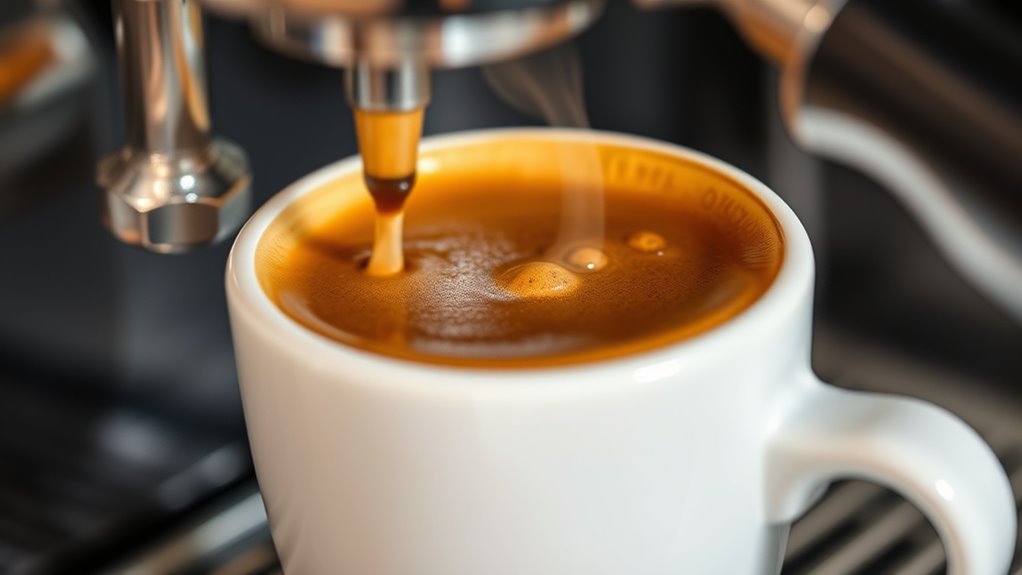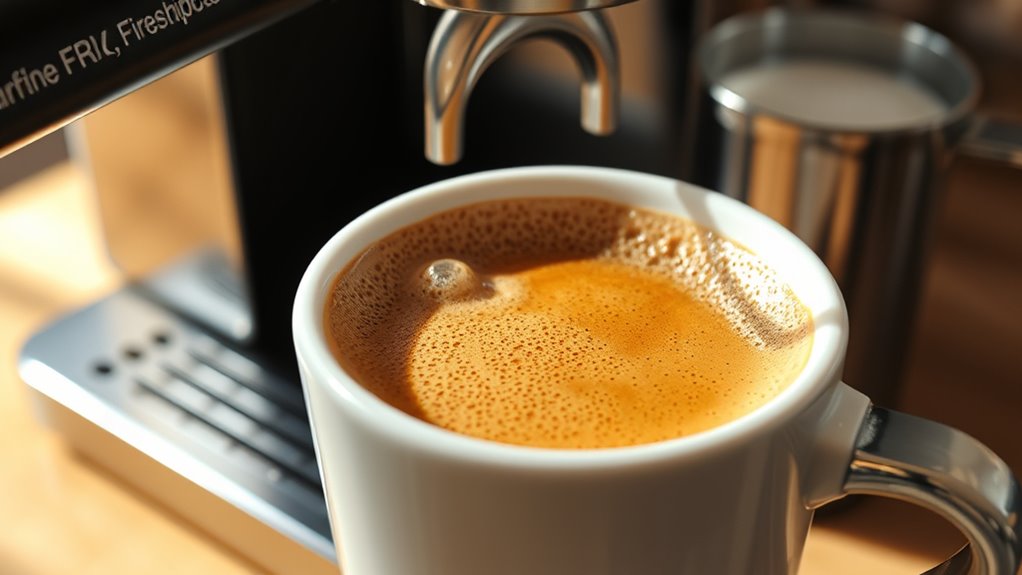So, when your espresso comes out foamy, it’s like a little celebration of flavor! That foam, or crema, forms when carbon dioxide and oils from fresh beans mix together during brewing. It’s super important to use fresh, good-quality beans and grind them just before brewing to get that rich texture. If your foam looks kinda thin or sad, don’t sweat it—there are ways to up your espresso game. Stick around to learn some handy tips!
At a Glance
- High pressure during extraction releases CO₂ from the beans, contributing to the foam’s formation and stability.
- Freshly roasted beans produce more gas, enhancing foam quality, especially when ground just before brewing.
- A fine, consistent grind size ensures proper extraction, leading to better foam and crema texture.
- Brewing at the ideal temperature (88°C to 96°C) and using filtered water can improve foam stability.
- Clean equipment is essential, as residues can negatively affect foam quality and overall espresso flavor.
Understanding Espresso Foam Formation

When you take a sip of that rich, velvety espresso and see the beautiful foam on top, you might wonder, “How does this magic happen?”
Well, it’s not just a caffeine fairy waving a wand! The secret lies in foam dynamics during extraction. As hot water meets coffee grounds, it releases trapped gases, mainly CO₂, creating bubbles. The pressure from your machine helps, too!
But it’s not just about bubbles; foam stability is key. With the right balance of oils and solids, your espresso’s foam can stand tall and proud, giving you that creamy goodness you crave.
Additionally, using a high-quality DeLonghi espresso machine can enhance the foam quality and overall flavor profile of your drink.
Isn’t that a tasty science?
The Role of Carbon Dioxide in Crema
Espresso’s magic isn’t just about the shiny machine or the fancy beans; a big part of it comes from that bubbly wonder called carbon dioxide.
When you brew, high pressure helps release CO₂ trapped in the beans, leading to that beautiful crema we all love.
Here’s why carbon dioxide is essential:
- It enhances carbon dioxide extraction during brewing.
- Pressure stabilizes the crema’s bubbles.
- CO₂ bubbles create a delightful texture.
- It helps retain flavors and aromas.
- Stable crema makes your espresso look enticing!
Additionally, the best cappuccino machine can help optimize the extraction process and improve the overall quality of your espresso.
Freshness and Roast Level Impact

If you want a perfect crema on your espresso, the freshness of your beans and their roast level are like your dynamic duo.
Fresh roast beans, especially medium to dark roast, pack a punch with oils and CO₂ that create that dreamy foam. Dark roasts might seem tempting, but too dark can lead to a thin crema—nobody wants that!
Remember, fresher beans mean more gas, which equals more foam. So, check that roast date, grind just before brewing, and you’ll be well on your way to espresso glory. A quality coffee grinder can also enhance the extraction process, leading to an even better foam.
Trust me, your taste buds will thank you for this foam-filled adventure!
Brewing Parameters for Optimal Crema
Getting that perfect crema on your espresso might feel like a secret art, but it all boils down to a few key brewing parameters.
Mastering the art of espresso crema is simpler than you think—just focus on a few essential brewing parameters!
Nail these, and you’ll be sipping like a barista in no time!
- Brewing temperature: Keep it between 88°C to 96°C.
- Grind consistency: Aim for a fine grind for proper extraction.
- Pressure: Brew at around 9 bars for that creamy goodness.
- Water quality: Use filtered water with the right minerals.
- Extraction time: Stick to 15-30 seconds for the best results.
Additionally, investing in a quality espresso machine can greatly enhance your ability to achieve optimal brewing conditions and create that luscious crema.
Follow these tips, and soon, you’ll be the proud owner of a gorgeous crema!
Comparing Espresso Foam to Milk Foam

When you sip on a delicious espresso or a creamy latte, have you ever stopped to think about the foam on top?
Espresso foam, or crema, is like a light, golden blanket made from coffee oils and tiny bubbles. It adds to the drink’s espresso texture, but don’t blink—it disappears fast!
On the other hand, milk foam is thicker with larger bubbles, thanks to all those proteins working hard. It can be super fluffy or silky smooth, depending on how it’s made. The quality of espresso foam can significantly depend on the automatic espresso machine used to brew it.
Indicators of Quality Espresso Crema
Espresso foam, or crema, isn’t just a pretty face on your coffee; it’s a big deal when it comes to quality.
You wanna know what to look for? Here are some key indicators:
- Hazelnut color with reddish hints
- A fine texture, free from large bubbles
- Thickness that’s just right, not too thick or thin
- Stays put longer, showing off its durability
- Color variations that hint at roast level or freshness
When you get this right, you’ll know you’ve got a cup of espresso that’s not just foamy, but a true delight! Additionally, achieving this rich crema often involves using high-quality coffee beans to enhance the flavor and aroma of your espresso.
Cheers to that!
Common Issues Affecting Foam Quality

Have you ever taken a sip of your espresso only to find the foam’s not living up to your caffeinated dreams? It can be a bummer!
If your grind size is too coarse or your tamping pressure is uneven, you might end up with sad, pale foam or big, bubbly messes. Over-extraction can lead to white foam that tastes bitter, while under-extraction leaves you with a watery disappointment.
Plus, don’t forget about that brewing time! Aim for 20 to 30 seconds, and keep your equipment clean. A little attention goes a long way in achieving that dreamy espresso foam you crave! Additionally, using a quality burr grinder can significantly enhance your grind consistency, which is essential for perfecting your espresso.
Tips for Improving Your Espresso Foam
If you’re tired of foam that looks more like a science experiment than a coffee masterpiece, don’t worry—you’re not alone!
Improving your espresso foam can be fun and rewarding. Here are some tips to elevate your coffee game:
- Choose whole or organic milk for creaminess.
- Master your steam technique by creating a vortex.
- Always use fresh, cold milk for better froth.
- Adjust grind size for a richer crema.
- Practice pouring slowly for perfect latte art.
Additionally, using high-quality whole bean espresso can significantly enhance your foam’s texture and flavor. With these simple tweaks, you’ll impress yourself and your friends with delicious, foamy espresso creations that taste as good as they look!





